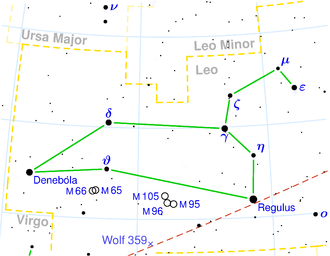NGC 3651
| Galaxy NGC 3651 |
|
|---|---|

|
|
| SDSS image from NGC 3651 | |
| AladinLite | |
| Constellation | lion |
|
Position equinox : J2000.0 , epoch : J2000.0 |
|
| Right ascension | 11 h 22 m 26.3 s |
| declination | + 24 ° 17 ′ 57 ″ |
| Appearance | |
| Morphological type | E. |
| Brightness (visual) | 13.6 mag |
| Brightness (B-band) | 14.6 mag |
| Angular expansion | 1.1 ′ × 1.1 ′ |
| Surface brightness | 13.9 mag / arcmin² |
| Physical data | |
| Redshift | 0.025438 ± 0.000083 |
| Radial velocity | (7626 ± 25) km / s |
|
Stroke distance v rad / H 0 |
(339 ± 24) x 10 6 ly (103.9 ± 7.3) Mpc |
| history | |
| discovery | Wilhelm Herschel |
| Discovery date | April 10, 1785 |
| Catalog names | |
| NGC 3651 • UGC 6388 • PGC 34898 • CGCG 126-042 • MCG + 04-27-028 • HCG 51A • GC 2392 • H III 335 • h 870 • HOLM 249A | |
NGC 3651 is an elliptical galaxy of Hubble type E in the constellation Leo. It is an estimated 339 million light years from the Milky Way and forms an optical pair of galaxies with PGC 34899 .
The object was discovered by Wilhelm Herschel on April 10, 1785 .
